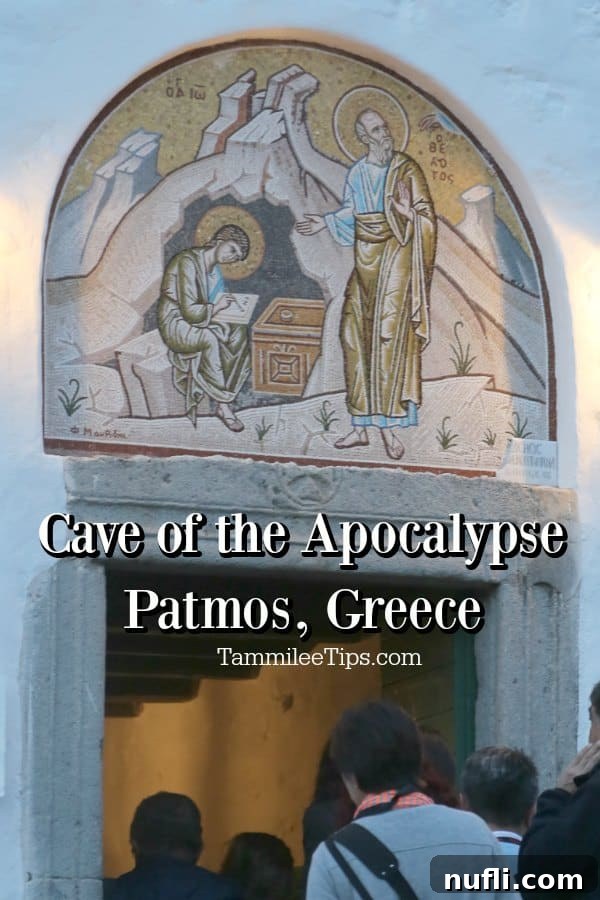Discovering Patmos: A Journey to St. John’s Monastery and the Cave of the Apocalypse
Patmos, a small yet profoundly significant island in the Aegean Sea, holds a unique place in history and spirituality. Known as the “Jerusalem of the Aegean,” it’s revered worldwide as the sacred island where Saint John the Theologian received his Revelations and penned the Book of Apocalypse. This spiritual aura, combined with its stunning natural beauty, picturesque villages, and rich Byzantine heritage, makes Patmos an unforgettable destination for travelers. Whether arriving by cruise ship or ferry, a visit to Patmos promises an immersive experience, with the Monastery of St. John and the Cave of the Apocalypse standing as its undisputed crown jewels. These UNESCO World Heritage sites offer not just historical insights but also a deep connection to early Christian history, attracting pilgrims and curious explorers alike to their hallowed grounds. For those seeking an enriching cultural and spiritual journey, Patmos truly delivers an unparalleled Greek island adventure.
Upon arrival, typically at the bustling port of Skala, visitors are greeted by a charming waterfront dotted with traditional tavernas and shops. However, the island’s most profound treasures await high above, nestled within the whitewashed Chora, a labyrinthine medieval village crowned by the imposing Monastery of St. John. The journey from Skala to these sacred sites is itself part of the experience. Cruise passengers often opt for organized shore excursions, which efficiently transport them to the vicinity of the Monastery and Cave. However, for independent travelers, local buses and taxis provide convenient access. Regardless of your mode of transport, be prepared for an ascent. The path to these ancient landmarks involves a scenic drive up winding roads, culminating in a significant amount of walking and ascending stairs, a detail crucial for planning your visit.
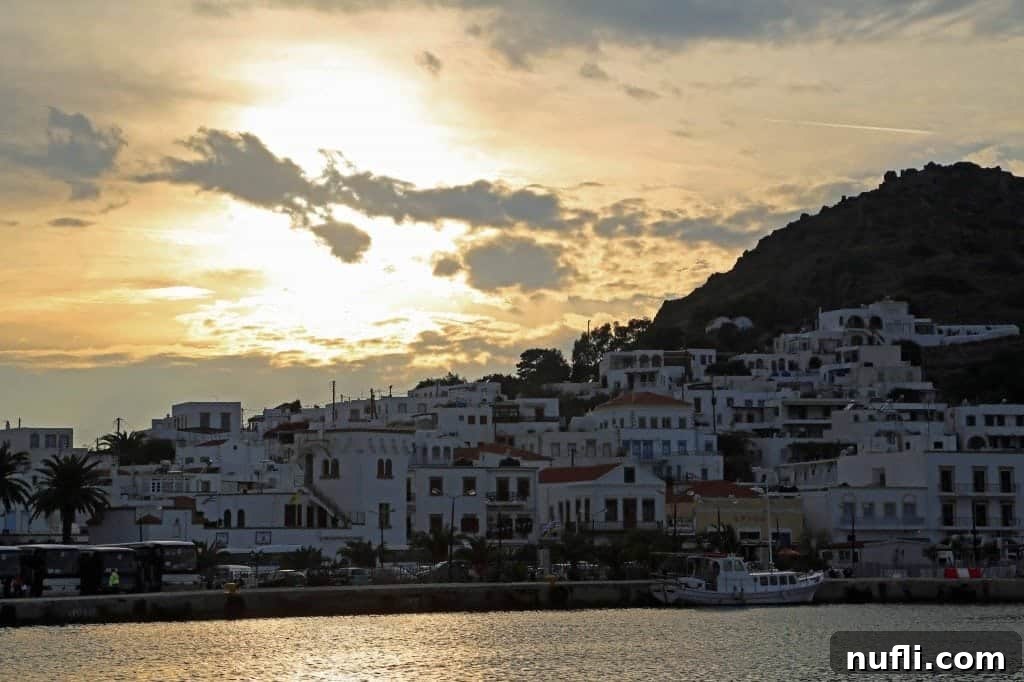
Often, cruise ships arrive in Patmos, offering passengers breathtaking views of the island’s dramatic landscape from the sea. As the ship approaches, the imposing presence of St. John’s Monastery, perched majestically atop the Chora, becomes clearly visible, hinting at the profound history awaiting discovery on the island. For cruise passengers, exploring Patmos through shore excursions is a popular and convenient option, ensuring you make the most of your time on this captivating island.
It’s essential to address the practicalities of exploring Patmos’s spiritual heart. The terrain leading up to both the Cave of the Apocalypse and the Monastery of St. John is undeniably challenging in parts. While buses can transport visitors most of the way up the hill to Chora, the final approach to the sites often requires navigating cobblestone pathways, uneven ground, and numerous steps. These stairs are not always uniform, varying in height and width, which can pose a challenge, especially for those with mobility issues. Therefore, selecting appropriate footwear is paramount for a comfortable and safe visit. Sturdy walking shoes, sneakers, or hiking sandals with excellent grip are highly recommended. Lightweight sandals or flip-flops, while suitable for beach strolls, will quickly prove inadequate and uncomfortable on Patmos’s historic pathways, potentially detracting from your overall experience. Prioritizing comfortable and supportive footwear will allow you to fully immerse yourself in the awe-inspiring surroundings without distraction.
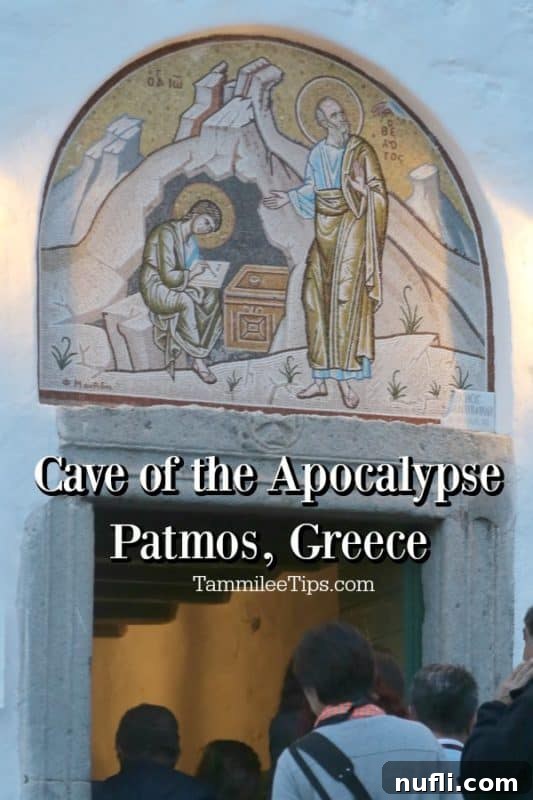
The Sacred Sanctuary: Exploring the Cave of the Apocalypse
Our spiritual journey on Patmos typically begins at the Cave of the Apocalypse, a site of immense spiritual significance for Christians worldwide. This humble grotto, carved into the side of a hill between Skala and Chora, is believed to be the very spot where Saint John the Theologian, exiled to Patmos in 95 AD, experienced his profound visions and dictated the Book of Revelation to his disciple Prochorus. Stepping into the cave is like stepping back in time, into a realm where the divine and earthly converged, leaving an indelible mark on religious history. The atmosphere within the cave is one of quiet reverence, a sacred hush falling over visitors as they enter this hallowed space.
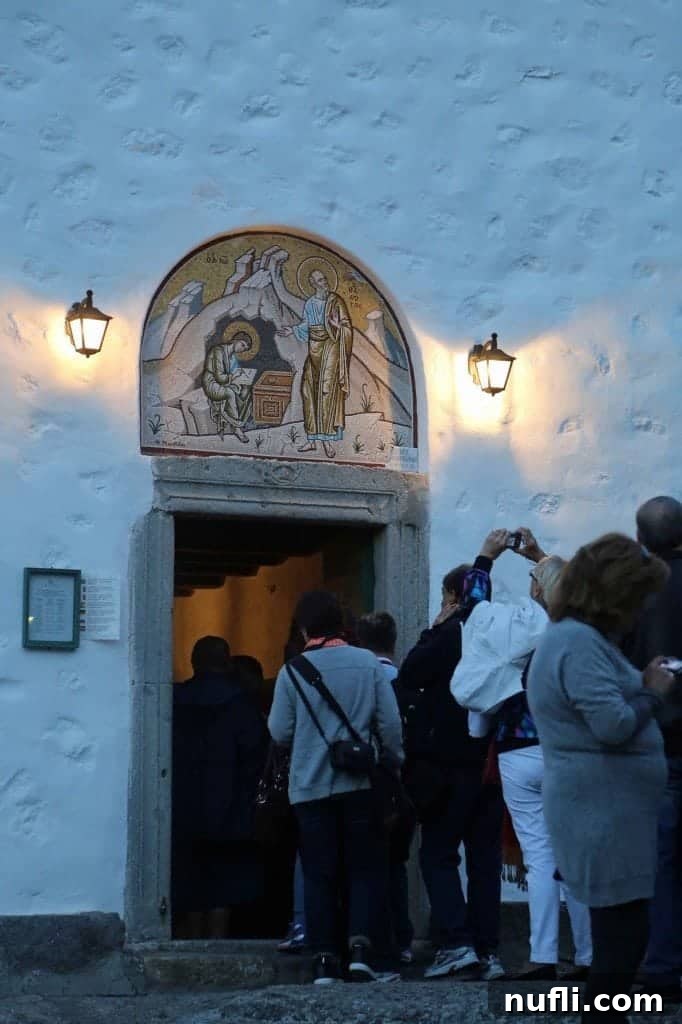
Although the visit is relatively brief, usually lasting 10-15 minutes, it is packed with moments of deep spiritual contemplation. Inside, pilgrims can observe several key features that underscore the cave’s biblical significance. One such feature is the triple fissure in the rock wall, said to have been formed when the voice of God spoke to St. John, revealing the prophecies of the Apocalypse. This iconic crack serves as a powerful reminder of the direct divine communication that occurred here. Another poignant detail is the small cross engraved by St. John himself, a tangible link to his presence. Visitors will also see the spot where St. John is believed to have rested, his head supported by a natural rock formation, a simple indentation in the stone that humanizes the saint’s incredible ordeal.
It’s important to note that photography is strictly prohibited inside the Cave of the Apocalypse, a measure taken to preserve the sanctity of the site and encourage visitors to experience it without the distraction of cameras. Given its popularity and profound importance, the cave can become quite crowded, especially during peak tourist season or when multiple cruise ships are in port. Expect to navigate several levels of steps both entering and exiting the grotto, and be prepared for a communal experience with many fellow travelers. Despite the brevity and the crowds, the opportunity to stand in the very place where such pivotal biblical events unfolded is a truly moving and unforgettable experience, offering a profound sense of connection to the foundations of Christian faith.
The Majestic Fortress: St. John’s Monastery of the Theologian
Perched like a Byzantine fortress high above the Aegean Sea, the Monastery of St. John the Theologian is not only the geographical but also the spiritual pinnacle of Patmos. Founded in 1088 by the Venerable Christodoulos, under the patronage of Byzantine Emperor Alexios I Komnenos, this monumental complex stands as a testament to centuries of unwavering faith and enduring cultural heritage. Its formidable walls, built to protect against pirate raids, encircle a treasury of religious art, ancient manuscripts, and vibrant frescoes, offering visitors a profound glimpse into Orthodox Christian traditions and Byzantine artistry.
The monastery’s architecture is a compelling blend of fortress-like austerity and intricate religious artistry. Upon entering the compound, visitors are transported into a world of serene courtyards, arcaded walkways, and chapels adorned with exquisite detail. The central feature is the Catholicon, the main church dedicated to Saint John the Theologian, which serves as the spiritual heart of the monastery. This magnificent church showcases an extraordinary wood-carved iconostasis, an intricately detailed screen separating the nave from the sanctuary, depicting saints and biblical scenes with remarkable skill. The entire structure, from its sturdy stone foundation to its decorative elements, reflects centuries of continuous worship and artistic development.

Within the Catholicon and various chapels, visitors are treated to a visual feast of frescoes and mosaics spanning several historical periods. These sacred artworks, some dating back to the Byzantine era, tell biblical stories and depict venerated saints with vivid colors and masterful compositions. Each fresco offers a window into the artistic and theological currents that shaped the Orthodox Church throughout its history. Beyond the main church, the monastery houses a small but incredibly rich museum. This treasure trove is home to a vast collection of religious artifacts, including priceless Byzantine icons, ancient manuscripts (some dating back to the 5th century), medieval textiles, richly embroidered sacerdotal vestments, and an array of other historical items that illuminate the monastery’s long and storied past. It’s a remarkable repository of faith, art, and knowledge, carefully preserved for future generations.
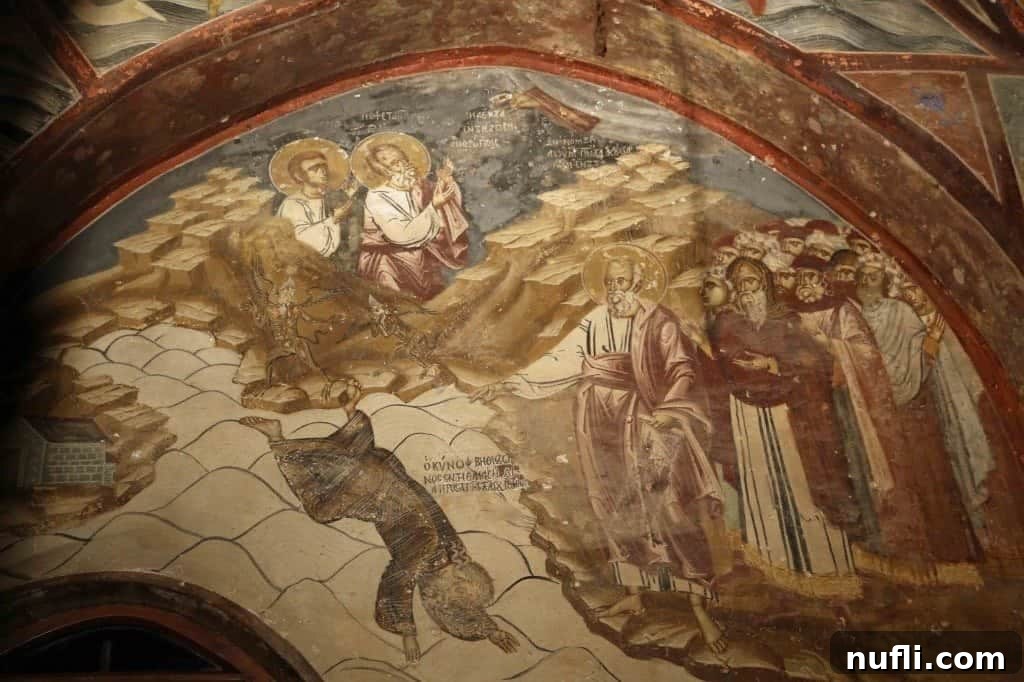

It is important to remember that St. John’s Monastery is not merely a historical site but a living, working monastery. Monks continue to reside and worship here daily, maintaining centuries-old traditions. Visitors are therefore encouraged to observe a respectful dress code and demeanor. Hats should be removed before entering the sacred spaces, and modest attire covering shoulders and knees is generally expected. While photography is generally permitted in the outdoor courtyards and areas offering panoramic views, it is strictly prohibited inside the churches, chapels, and the museum, particularly for the frescoes and religious relics, to preserve their delicate nature and maintain the sanctity of the worship spaces. This respect for the sacred environment ensures a harmonious experience for both pilgrims and tourists.
Beyond the Sacred Sites: Experiencing Patmos
While the Monastery of St. John and the Cave of the Apocalypse are undoubtedly the spiritual anchors of Patmos, the island offers much more to explore. The Chora, the fortified medieval town surrounding the monastery, is a UNESCO World Heritage site in itself. Its narrow, winding alleyways, whitewashed houses, and traditional courtyards create an enchanting atmosphere perfect for leisurely strolls. Discover hidden gems in small boutiques, enjoy a coffee at a charming cafe, or simply soak in the timeless beauty of this historic settlement.
The elevated position of the Chora and the Monastery provides some of the most spectacular panoramic views in the Aegean. From various vantage points, visitors can gaze across the sparkling blue sea, admire the intricate coastline of Patmos, and observe neighboring islands on a clear day. For cruise passengers, especially those whose itineraries include an evening visit, the view of their illuminated ship anchored in the bay against the backdrop of a Patmos sunset or starlit night is truly magical. This unique perspective transforms the experience, adding another layer of wonder to an already captivating destination. The tranquility of Patmos at night, with the Chora’s lights twinkling, creates an indelible memory.
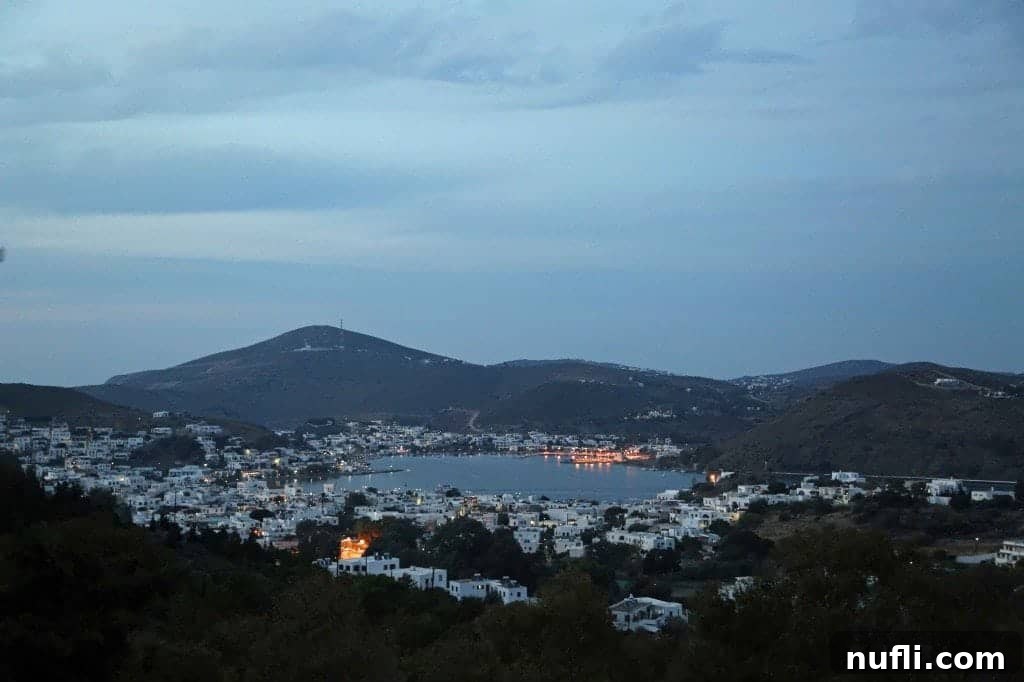
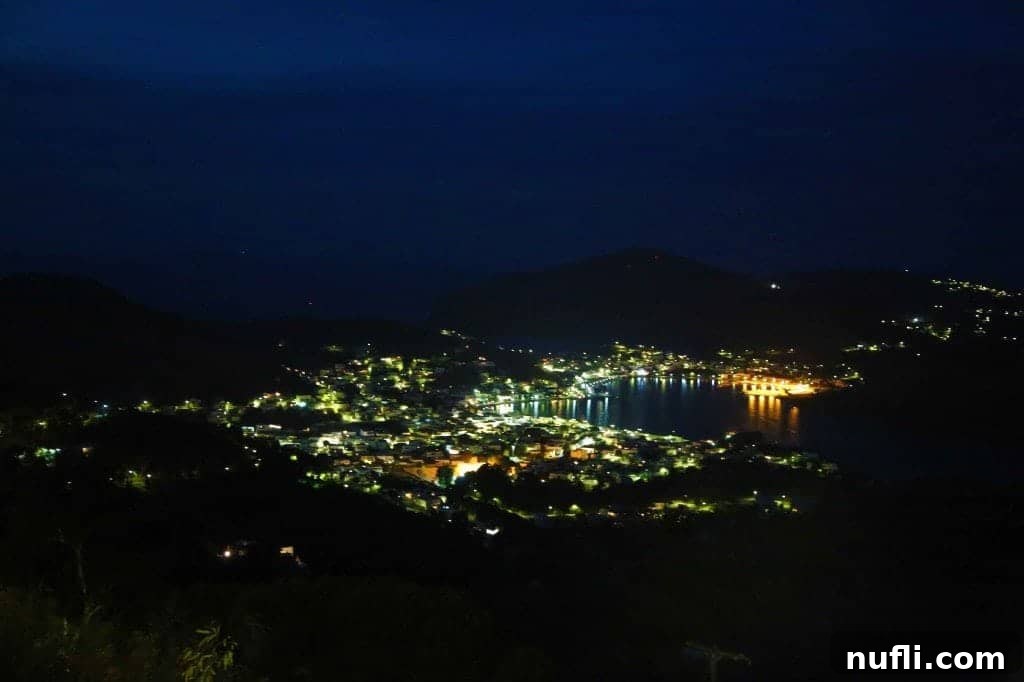
Planning Your Patmos Adventure: Essential Tips
To ensure a smooth and memorable visit to Patmos, consider these additional tips:
Best Time to Visit
The shoulder seasons (April-May and September-October) offer pleasant weather, fewer crowds, and a more serene experience. Summer months (June-August) are vibrant but can be very hot and crowded, particularly around the main religious sites.
Getting Around Patmos
While walking is part of the charm, taxis are readily available at Skala port. There’s also a local bus service connecting Skala with Chora and some of the island’s popular beaches. Renting a scooter or car for a day can also be an excellent way to explore more remote parts of the island and discover its hidden corners.
Local Cuisine and Culture
Don’t leave Patmos without sampling its delicious local cuisine. Fresh seafood, traditional Greek dishes, and local specialties await in Skala and Chora’s tavernas. Engage with the friendly locals, embrace the laid-back island rhythm, and perhaps explore some of Patmos’s beautiful beaches like Grikos or Psili Ammos for a refreshing dip after your historical exploration.
Booking Tours and Excursions
For cruise ship passengers, organized shore excursions are a convenient way to visit both the Cave of the Apocalypse and St. John’s Monastery, often including transportation and a knowledgeable guide. For independent travelers, consider booking local tours in advance to enhance your understanding of these profound sites.
You can discover a range of exciting Patmos Tours to enrich your visit and gain deeper insights into the island’s history and culture.
For accommodation options, explore a variety of Hotels and Vacation Rentals on Patmos to suit your travel style and budget.
Conclusion: A Journey of Faith and Beauty
Patmos, the “Island of Revelation,” offers a profoundly moving experience that transcends typical tourism. From the solemn reverence of the Cave of the Apocalypse, where divine words were whispered, to the majestic grandeur of St. John’s Monastery, a living testament to Byzantine heritage, every corner of this island resonates with history and spirituality. Beyond its iconic religious sites, Patmos captivates with its enchanting Chora, breathtaking vistas, and warm Aegean hospitality. A visit here is not merely a trip; it’s a pilgrimage, a cultural immersion, and an unforgettable journey that connects visitors to a sacred past and the enduring beauty of the Greek islands. Prepare to be inspired, to reflect, and to carry a piece of Patmos’s unique spirit with you long after you’ve departed its shores.
Explore More of Europe
If you’re planning further European adventures, delve into these related articles:
- The Charming Cats of Greece and the Mediterranean
- Your Epic Guide to Experiencing Sunset in Oia, Santorini, Greece
- Essential Tips for Visiting Mykonos by Cruise Ship
- Uncovering the Ancient Terra Cotta Houses of Ephesus, Turkey
- A Visual Journey: Photo Tour of Ancient Ephesus, Turkey
For a comprehensive look at all our travel advice, explore our extensive collection of Europe Travel Guides.
